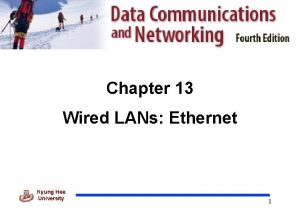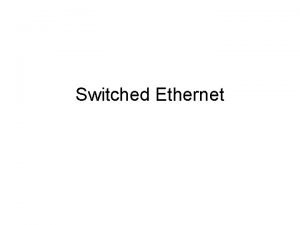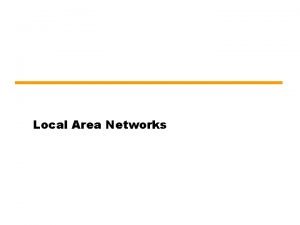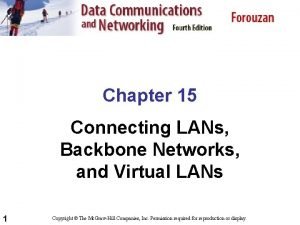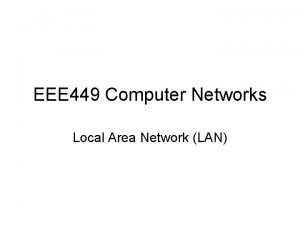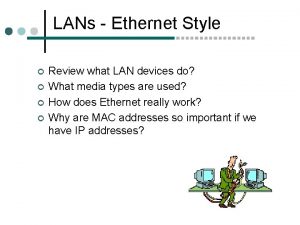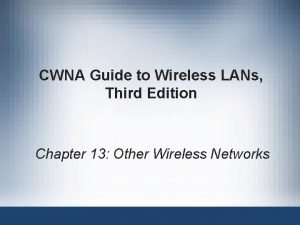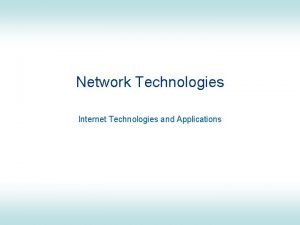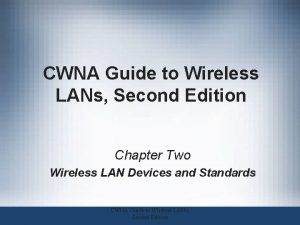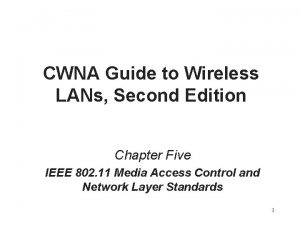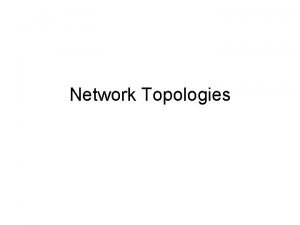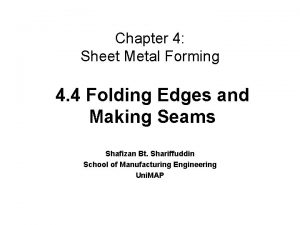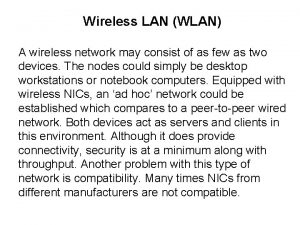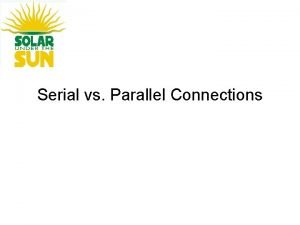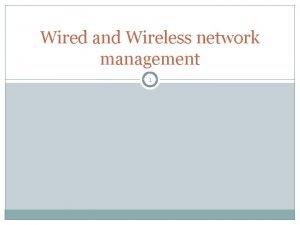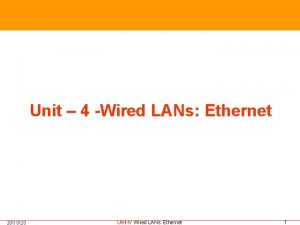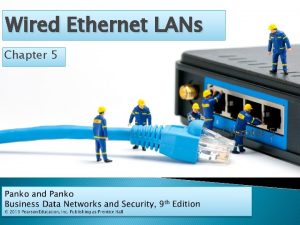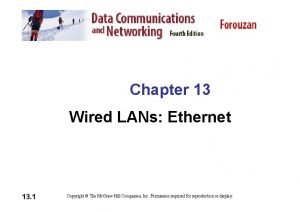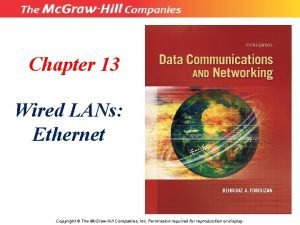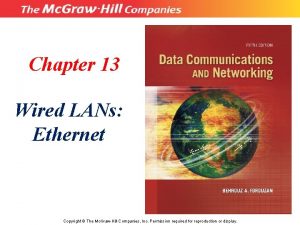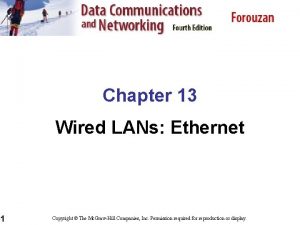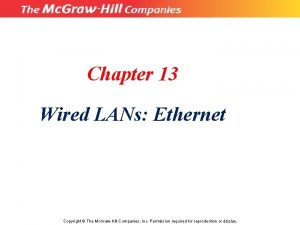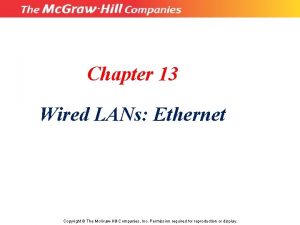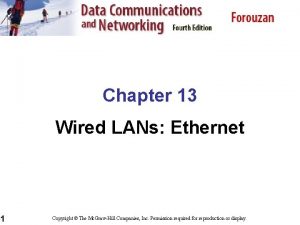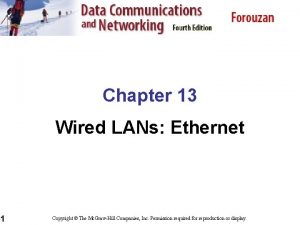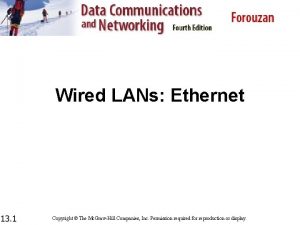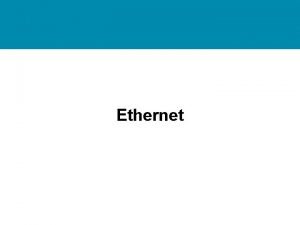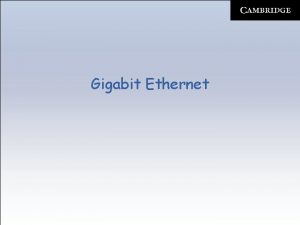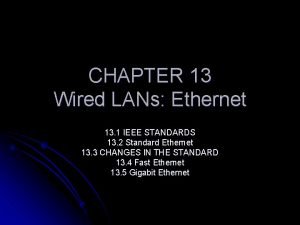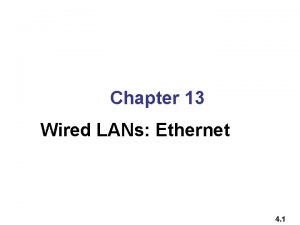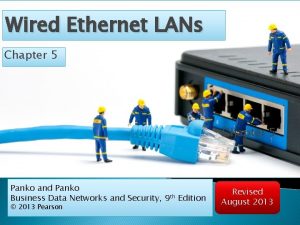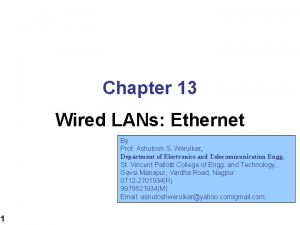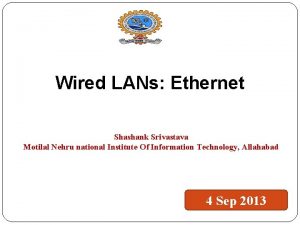Chapter 13 Wired LANs Ethernet Copyright The Mc













































- Slides: 45

Chapter 13 Wired LANs: Ethernet Copyright © The Mc. Graw-Hill Companies, Inc. Permission required for reproduction or display.

Chapter 5: Outline 13. 1 ETHERNET PROTOCOL 13. 2 STANDARD ETHERNET 13. 3 FAST ETHERNET 13. 4 GIGABIT ETHERNET 13. 5 10 GIGABIT ETHERNET

13 -1 ETHERNET PROTOCOL The data-link layer and the physical layer are the territory of the local and wide area networks. This means that when we discuss these two layers, we are talking about networks that are using them. As we see in this and the following two chapters, we can have wired or wireless networks. We discuss wired networks in this chapter and the next. 13. 3

13. 1 IEEE Project 802 In 1985, the Computer Society of the IEEE started a project, called Project 802, to set standards to enable intercommunication among equipment from a variety of manufacturers. Project 802 does not seek to replace any part of the OSI model or TCP/IP protocol suite. Instead, it is a way of specifying functions of the physical layer and the data-link layer of major LAN protocols. The relationship of the 802 Standard to the TCP/IP protocol suite is shown in Figure 13. 4

Figure 13. 1: IEEE standard for LANs 13. 5

13. 2 Ethernet Evolution The Ethernet LAN was developed in the 1970 s by Robert Metcalfe and David Boggs. Since then, it has gone through four generations: Standard Ethernet (10 Mbps), Fast Ethernet (100 Mbps), Gigabit Ethernet (1 Gbps), and 10 Gigabit Ethernet (10 Gbps), as shown in Figure 13. 2. We briefly discuss all these generations. 13. 6

Figure 13. 2 : Ethernet evolution 13. 7

13 -2 STANDARD ETHERNET We refer to the original Ethernet technology with the data rate of 10 Mbps as the Standard Ethernet. Although most implementations have moved to other technologies in the Ethernet evolution, there are some features of the Standard Ethernet that have not changed during the evolution. We discuss this standard version first. 13. 8

13. 2. 1 Characteristics Let us first discuss some characteristics of the Standard Ethernet. 13. 9

Figure 13. 3: Ethernet frame 13. 10

Example 13. 1 Show the address 47: 20: 1 B: 2 E: 08: EE is sent out online. Solution The address is sent left to right, byte by byte; for each byte, it is sent right to left, bit by bit, as shown below: 13. 11

13. 2. 2 Addressing Each station on an Ethernet network (such as a PC, workstation, or printer) has its own network interface card (NIC). The NIC fits inside the station and provides the station with a link-layer address. The Ethernet address is 6 bytes (48 bits), normally written in hexadecimal notation, with a colon between the bytes. For example, the following shows an Ethernet MAC address: 13. 12

Figure 13. 4: Unicast and multicast addresses 13. 13

Example 13. 2 Define the type of the following destination addresses: a. 4 A: 30: 10: 21: 10: 1 A b. 47: 20: 1 B: 2 E: 08: EE c. FF: FF: FF: FF Solution To find the type of the address, we need to look at the second hexadecimal digit from the left. If it is even, the address is unicast. If it is odd, the address is multicast. If all digits are Fs, the address is broadcast. Therefore, we have the following: 13. 14

Example 13. 2 (continued) a. This is a unicast address because A in binary is 1010 (even). b. This is a multicast address because 7 in binary is 0111 (odd). c. This is a broadcast address because all digits are Fs in hexadecimal. 13. 15

Figure 13. 5: Implementation of standard Ethernet 13. 16

13. 2. 3 Access Method Since the network that uses the standard Ethernet protocol is a broadcast network, we need to use an access method to control access to the sharing medium. The standard Ethernet chose CSMA/CD with 1 -persistent method, discussed earlier in Chapter 12, Section 13. 3. Let us use a scenario to see how this method works for the Ethernet protocol. 13. 17

Figure 12. 14 Flow diagram for the CSMA/CD 12. 18

13. 2. 4 Efficiency of Standard Ethernet The efficiency of the Ethernet is defined as the ratio of the time used by a station to send data to the time the medium is occupied by this station. The practical efficiency of standard Ethernet has been measured to be 13. 19

Example 13. 3 In the Standard Ethernet with the transmission rate of 10 Mbps, we assume that the length of the medium is 2500 m and the size of the frame is 512 bits. The propagation speed of a signal in a cable is normally 2 × 108 m/s. The example shows that a = 0. 24, which means only 0. 24 of a frame occupies the whole medium in this case. The efficiency is 39 percent, which is considered moderate; it means that only 61 percent of the time the medium is occupied but not used by a station. 13. 20

13. 2. 5 Implementation The Standard Ethernet defined several implementations, but only four of them became popular during the 1980 s. Table 13. 1 shows a summary of Standard Ethernet implementations. 13. 21

Table 13. 1: Summary of Standard Ethernet implementations 13. 22

Figure 13. 6: Encoding in a Standard Ethernet 13. 23

Figure 13. 7: 10 Base 5 implementation 13. 24

Figure 13. 8: 10 Base 2 implementation 13. 25

Figure 13. 9: 10 Base-T implementation 13. 26

Figure 13. 10: 10 Base-F implementation 13. 27

13. 2. 6 Changes in the Standard Before we discuss higher-rate Ethernet protocols, we need to discuss the changes that occurred to the 10 Mbps Standard Ethernet. These changes actually opened the road to the evolution of the Ethernet to become compatible with other high-data-rate LANs. 13. 28

Figure 13. 12: A network with and without bridging 13. 30

Figure 13. 13: Collision domains 13. 31

Figure 13. 14: Switched Ethernet 13. 32

Figure 13. 15: Full – duplex switched Ethernet 13. 33

13 -3 FAST ETHERNET In the 1990 s, Ethernet made a big jump by increasing the transmission rate to 100 Mbps, and the new generation was called the Fast Ethernet. The designers of the Fast Ethernet needed to make it compatible with the Standard Ethernet. The MAC sublayer was left unchanged. But the features of the Standard Ethernet that depend on the transmission rate, had to be changed. 13. 34

13. 3. 1 Access Method We remember that the properation of the CSMA/CD depends on the transmission rate, the minimum size of the frame, and the maximum network length. If we want to keep the minimum size of the frame, the maximum length of the network should be changed. In other words, if the minimum frame size is still 512 bits, and it is transmitted 10 times faster, the collision needs to be detected 10 times sooner, which means the maximum length of the network should be 10 times shorter (the propagation speed does not change). 13. 35

13. 3. 2 Physical Layer To be able to handle a 100 Mbps data rate, several changes need to be made at the physical layer. 13. 36

Figure 13. 16: Encoding for fast Ethernet 13. 37

Table 13. 2: Summary of Fast Ethernet implementations 13. 38

13 -4 GIGABIT ETHERNET The need for an even higher data rate resulted in the design of the Gigabit Ethernet Protocol (1000 Mbps). The IEEE committee calls it the Standard 802. 3 z. The goals of the Gigabit Ethernet were to upgrade the data rate to 1 Gbps, but keep the address length, the frame format, and the maximum and minimum frame length the same. 13. 39

13. 4. 1 MAC Sublayer A main consideration in the evolution of Ethernet was to keep the MAC sublayer untouched. However, to achieve a data rate of 1 Gbps, this was no longer possible. Gigabit Ethernet has two distinctive approaches for medium access: half-duplex and fullduplex. Almost all implementations of Gigabit Ethernet follow the full-duplex approach, so we mostly ignore the half-duplex mode. 13. 40

13. 4. 2 Physical Layer The physical layer in Gigabit Ethernet is more complicated than that in Standard or Fast Ethernet. We briefly discuss some features of this layer. 13. 41

Figure 13. 17: Encoding in Gigabit Ethernet 13. 42

Table 13. 3: Summary of Gigabit Ethernet implementations 13. 43

13 -5 10 -GIGABIT EHTERNET In recent years, there has been another look into the Ethernet for use in metropolitan areas. The idea is to extend the technology, the data rate, and the coverage distance so that the Ethernet can be used as LAN and MAN (metropolitan area network). The IEEE committee created 10 Gigabit Ethernet and called it Standard 802. 3 ae. 13. 44

13. 5. 1 Implementation 10 Gigabit Ethernet operates only in full-duplex mode, which means there is no need for contention; CSMA/CD is not used in 10 Gigabit Ethernet. Four implementations are the most common: 10 GBase. SR, 10 GBase-LR, 10 GBase-EW, and 10 GBase-X 4. Table 13. 4 shows a summary of the 10 Gigabit Ethernet implementations. We discussed the encoding in Chapter 4. 13. 45

Table 13. 4: Summary of 10 -Gigabit Ethernet implementations 13. 46
 Wired lans ethernet
Wired lans ethernet Unicast
Unicast Switched ethernet vs shared ethernet
Switched ethernet vs shared ethernet Tenth chapter wired
Tenth chapter wired High speed lans
High speed lans Connecting remote lans
Connecting remote lans Lan
Lan Lans style
Lans style Cwna guide to wireless lans 3rd edition
Cwna guide to wireless lans 3rd edition Internet technologies and applications
Internet technologies and applications Show that the maximum efficiency of pure aloha is 1/(2e)
Show that the maximum efficiency of pure aloha is 1/(2e) Adam lans
Adam lans Cwna guide to wireless lans
Cwna guide to wireless lans Cwna guide to wireless lans
Cwna guide to wireless lans Googlenomics
Googlenomics Star wired ring topology
Star wired ring topology Benefits of transferring data over a wired network
Benefits of transferring data over a wired network 06 91714313
06 91714313 Dovetail seam
Dovetail seam What does a wireless lan (wlan) act as to a wired network?
What does a wireless lan (wlan) act as to a wired network? Wired vs wireless broadband
Wired vs wireless broadband Serial vs parallel battery
Serial vs parallel battery Understanding wired and wireless networks
Understanding wired and wireless networks Kepanjangan dari utp pada media wired adalah
Kepanjangan dari utp pada media wired adalah Hình ảnh bộ gõ cơ thể búng tay
Hình ảnh bộ gõ cơ thể búng tay Bổ thể
Bổ thể Tỉ lệ cơ thể trẻ em
Tỉ lệ cơ thể trẻ em Gấu đi như thế nào
Gấu đi như thế nào Tư thế worm breton là gì
Tư thế worm breton là gì Chúa yêu trần thế alleluia
Chúa yêu trần thế alleluia Các môn thể thao bắt đầu bằng tiếng nhảy
Các môn thể thao bắt đầu bằng tiếng nhảy Thế nào là hệ số cao nhất
Thế nào là hệ số cao nhất Các châu lục và đại dương trên thế giới
Các châu lục và đại dương trên thế giới Công thức tính độ biến thiên đông lượng
Công thức tính độ biến thiên đông lượng Trời xanh đây là của chúng ta thể thơ
Trời xanh đây là của chúng ta thể thơ Mật thư tọa độ 5x5
Mật thư tọa độ 5x5 Phép trừ bù
Phép trừ bù Phản ứng thế ankan
Phản ứng thế ankan Các châu lục và đại dương trên thế giới
Các châu lục và đại dương trên thế giới Thơ thất ngôn tứ tuyệt đường luật
Thơ thất ngôn tứ tuyệt đường luật Quá trình desamine hóa có thể tạo ra
Quá trình desamine hóa có thể tạo ra Một số thể thơ truyền thống
Một số thể thơ truyền thống Cái miệng bé xinh thế chỉ nói điều hay thôi
Cái miệng bé xinh thế chỉ nói điều hay thôi Vẽ hình chiếu vuông góc của vật thể sau
Vẽ hình chiếu vuông góc của vật thể sau Nguyên nhân của sự mỏi cơ sinh 8
Nguyên nhân của sự mỏi cơ sinh 8
